Abstract
The role of hemolysin in the nephropathogenicity of Escherichia coli was studied in a hematogenous pyelonephritis model in mice. The nephropathogenicity of a nonhemolytic, avirulent E. coli strain was increased by simultaneous injection with its hemolytic, nephropathogenic parent. This helper mechanism could be attributed to hemolysin, since the simultaneous injection of partially purified hemolysin gave a similar enhancement of nephropathogenicity. Intraperitoneal injection of hemoglobin or iron sulfate before intravenous challenge with this avirulent strain also led to increased virulence. The nephropathogenicity-enhancing effect of hemolysin is therefore supposed to depend on increasing the level of available iron in the host. Under conditions of plentiful iron, hemolysin production was repressed, as shown by in vitro growth experiments in the presence of exogenous iron. These results suggest that the production of hemolysin is regulated by feedback inhibition.
Full text
PDF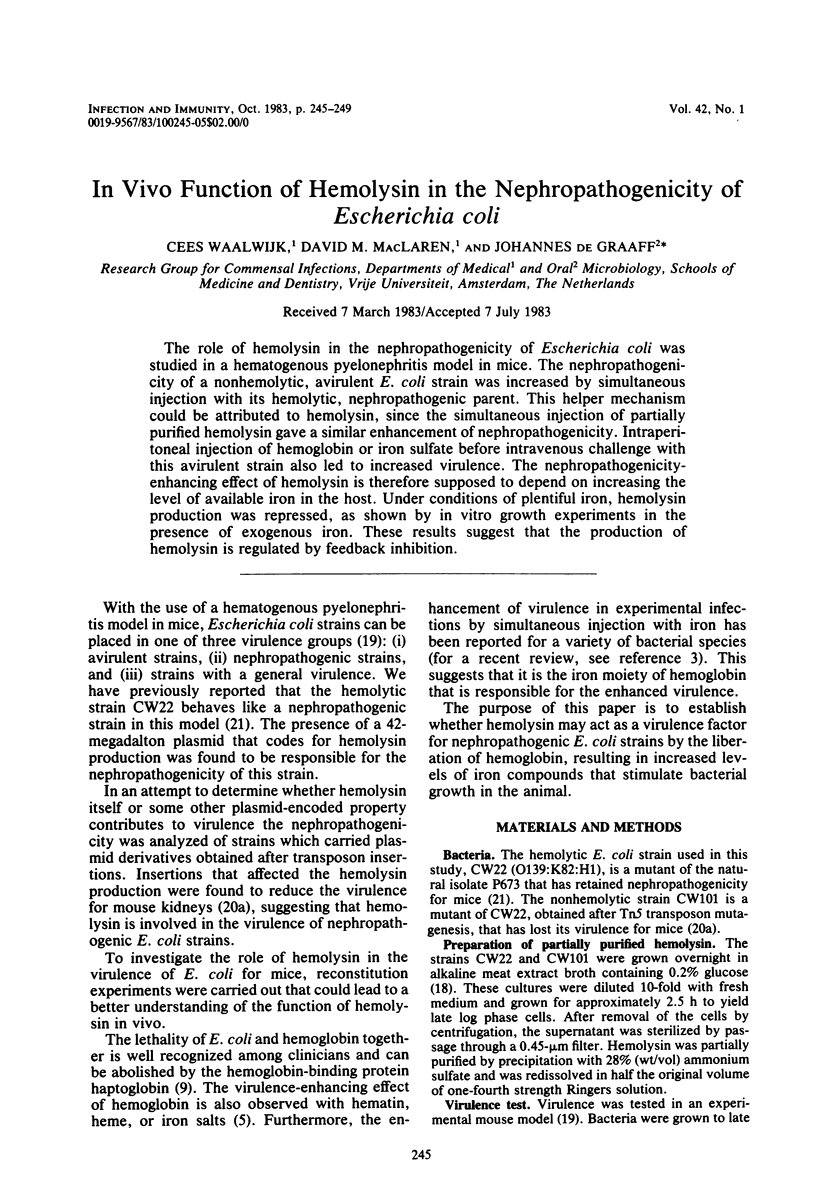
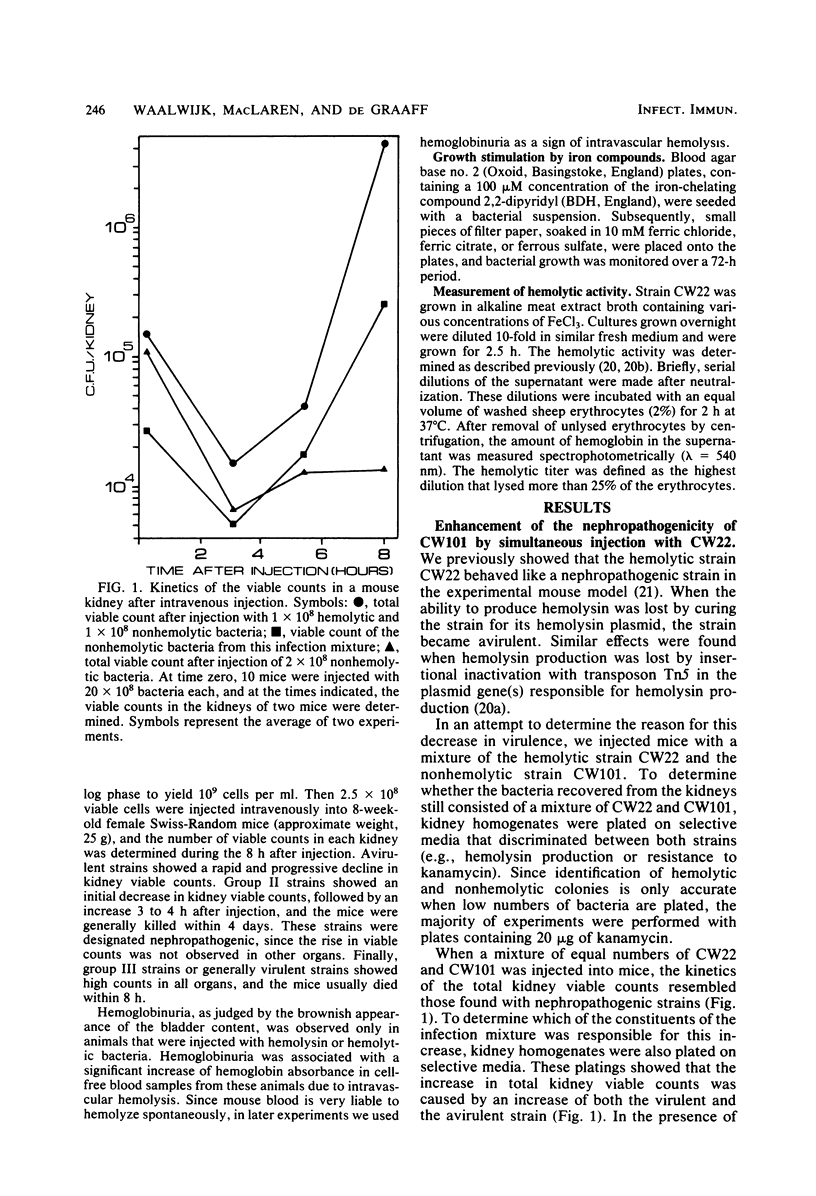
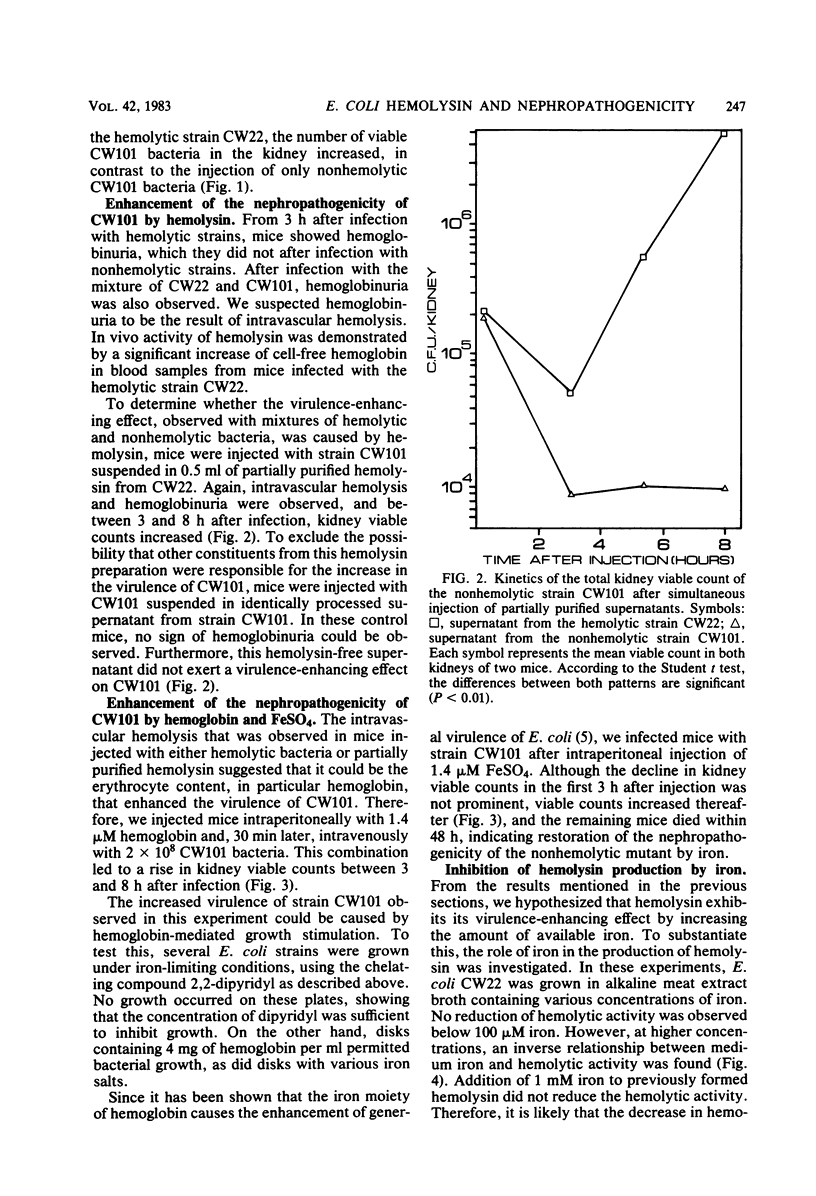
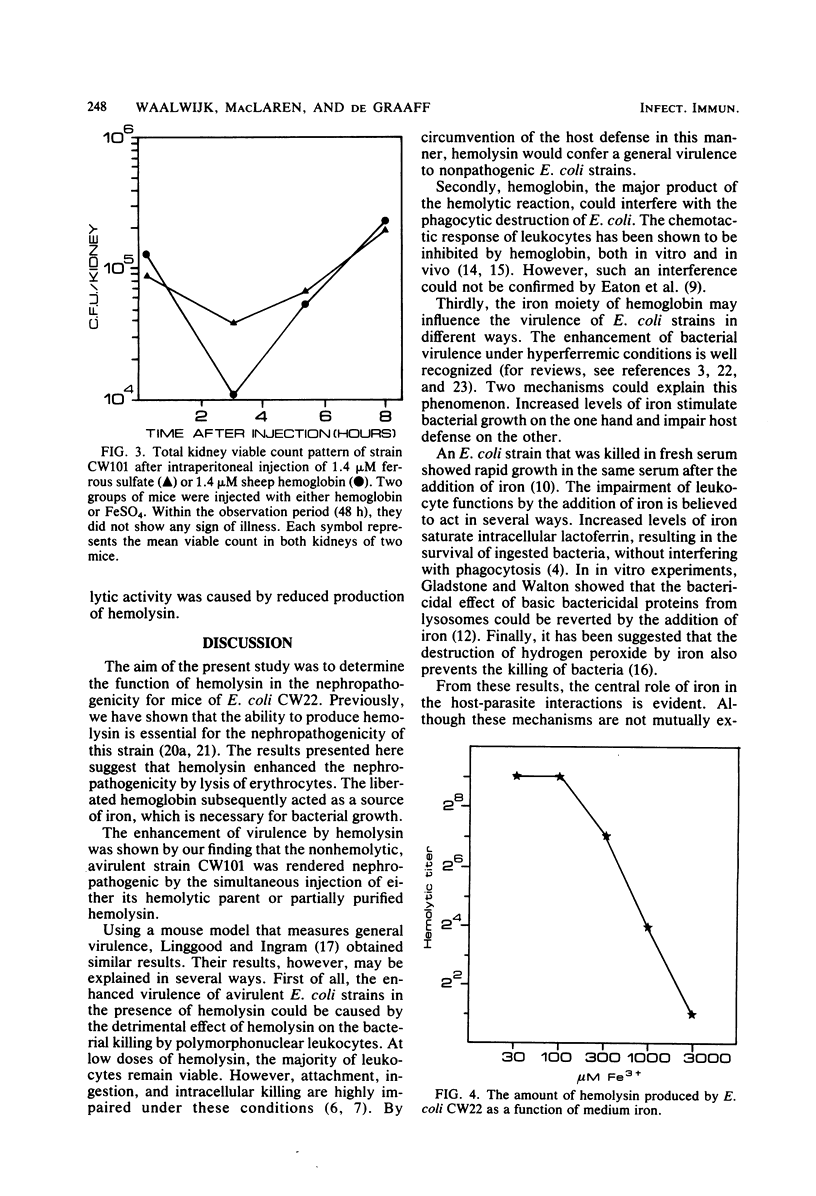
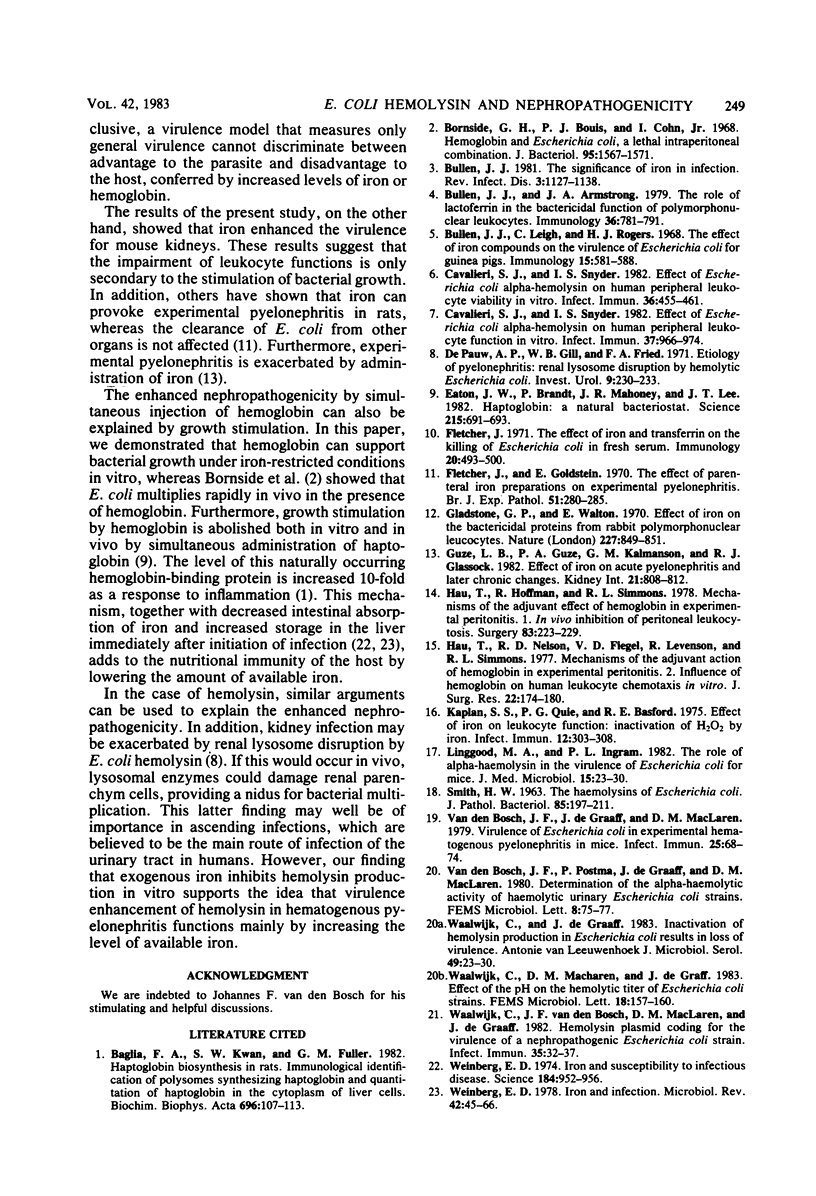
Selected References
These references are in PubMed. This may not be the complete list of references from this article.
- Baglia F. A., Kwan S. W., Fuller G. M. Haptoglobin biosynthesis in rats. Immunological identification of polysomes synthesizing haptoglobin and quantitation of haptoglobin in the cytoplasm of liver cells. Biochim Biophys Acta. 1982 Jan 26;696(1):107–113. doi: 10.1016/0167-4781(82)90016-1. [DOI] [PubMed] [Google Scholar]
- Bornside G. H., Bouis P. J., Jr, Cohn I., Jr Hemoglobin and Escherichia coli, a lethal intraperitoneal combination. J Bacteriol. 1968 May;95(5):1567–1571. doi: 10.1128/jb.95.5.1567-1571.1968. [DOI] [PMC free article] [PubMed] [Google Scholar]
- Bullen J. J., Armstrong J. A. The role of lactoferrin in the bactericidal function of polymorphonuclear leucocytes. Immunology. 1979 Apr;36(4):781–791. [PMC free article] [PubMed] [Google Scholar]
- Bullen J. J., Leigh L. C., Rogers H. J. The effect of iron compounds on the virulence of Escherichia coli for guinea-pigs. Immunology. 1968 Oct;15(4):581–588. [PMC free article] [PubMed] [Google Scholar]
- Bullen J. J. The significance of iron in infection. Rev Infect Dis. 1981 Nov-Dec;3(6):1127–1138. doi: 10.1093/clinids/3.6.1127. [DOI] [PubMed] [Google Scholar]
- Cavalieri S. J., Snyder I. S. Effect of Escherichia coli alpha-hemolysin on human peripheral leukocyte function in vitro. Infect Immun. 1982 Sep;37(3):966–974. doi: 10.1128/iai.37.3.966-974.1982. [DOI] [PMC free article] [PubMed] [Google Scholar]
- Cavalieri S. J., Snyder I. S. Effect of Escherichia coli alpha-hemolysin on human peripheral leukocyte viability in vitro. Infect Immun. 1982 May;36(2):455–461. doi: 10.1128/iai.36.2.455-461.1982. [DOI] [PMC free article] [PubMed] [Google Scholar]
- Eaton J. W., Brandt P., Mahoney J. R., Lee J. T., Jr Haptoglobin: a natural bacteriostat. Science. 1982 Feb 5;215(4533):691–693. doi: 10.1126/science.7036344. [DOI] [PubMed] [Google Scholar]
- Fletcher J., Goldstein E. The effect of parenteral iron preparations on experimental pyelonephritis. Br J Exp Pathol. 1970 Jun;51(3):280–285. [PMC free article] [PubMed] [Google Scholar]
- Fletcher J. The effect of iron and transferrin on the killing of Escherichia coli in fresh serum. Immunology. 1971 Apr;20(4):493–500. [PMC free article] [PubMed] [Google Scholar]
- Gladstone G. P., Walton E. Effect of iron on the bactericidal proteins from rabbit polymorphonuclear leukocytes. Nature. 1970 Aug 22;227(5260):849–851. doi: 10.1038/227849a0. [DOI] [PubMed] [Google Scholar]
- Guze L. B., Guze P. A., Kalmanson G. M., Glassock R. J. Effect of iron on acute pyelonephritis and later chronic changes. Kidney Int. 1982 Jun;21(6):808–812. doi: 10.1038/ki.1982.103. [DOI] [PubMed] [Google Scholar]
- Hau T., Hoffman R., Simmons R. L. Mechanisms of the adjuvant effect of hemoglobin in experimental peritonitis. I. In vivo inhibition of peritoneal leukocytosis. Surgery. 1978 Feb;83(2):223–229. [PubMed] [Google Scholar]
- Hau T., Nelson R. D., Fiegel V. D., Levenson R., Simmons R. L. Mechanisms of the adjuvant action of hemoglobin in experimental peritonitis. 2. Influence of hemoglobin on human leukocyte chemotaxis in vitro. J Surg Res. 1977 Mar;22(3):174–180. doi: 10.1016/0022-4804(77)90131-7. [DOI] [PubMed] [Google Scholar]
- Kaplan S. S., Quie P. G., Basford R. E. Effect of iron on leukocyte function: inactivation of H2O2 BY IRON. Infect Immun. 1975 Aug;12(2):303–308. doi: 10.1128/iai.12.2.303-308.1975. [DOI] [PMC free article] [PubMed] [Google Scholar]
- Linggood M. A., Ingram P. L. The role of alpha haemolysin in the virulence of Escherichia coli for mice. J Med Microbiol. 1982 Feb;15(1):23–30. doi: 10.1099/00222615-15-1-23. [DOI] [PubMed] [Google Scholar]
- SMITH H. W. The haemolysins of Escherichia coli. J Pathol Bacteriol. 1963 Jan;85:197–211. doi: 10.1002/path.1700850119. [DOI] [PubMed] [Google Scholar]
- Waalwijk C., de Graaff J. Inactivation of haemolysin production in Escherichia coli by transposon insertion results in loss of virulence. Antonie Van Leeuwenhoek. 1983 Apr;49(1):23–30. doi: 10.1007/BF00457876. [DOI] [PubMed] [Google Scholar]
- Waalwijk C., van den Bosch J. F., MacLaren D. M., de Graaff J. Hemolysin plasmid coding for the virulence of a nephropathogenic Escherichia coli strain. Infect Immun. 1982 Jan;35(1):32–37. doi: 10.1128/iai.35.1.32-37.1982. [DOI] [PMC free article] [PubMed] [Google Scholar]
- Weinberg E. D. Iron and infection. Microbiol Rev. 1978 Mar;42(1):45–66. doi: 10.1128/mr.42.1.45-66.1978. [DOI] [PMC free article] [PubMed] [Google Scholar]
- Weinberg E. D. Iron and susceptibility to infectious disease. Science. 1974 May 31;184(4140):952–956. doi: 10.1126/science.184.4140.952. [DOI] [PubMed] [Google Scholar]
- de Pauw A. P., Gill W. B., Fried F. A. Etiology of pyelonephritis. Renal lysosome disruption by hemolytic Escherichia coli. Invest Urol. 1971 Nov;9(3):230–233. [PubMed] [Google Scholar]
- van den Bosch J. F., de Graaff J., MacLaren D. M. Virulence of Escherichia coli in experimental hematogenous pyelonephritis in mice. Infect Immun. 1979 Jul;25(1):68–74. doi: 10.1128/iai.25.1.68-74.1979. [DOI] [PMC free article] [PubMed] [Google Scholar]


